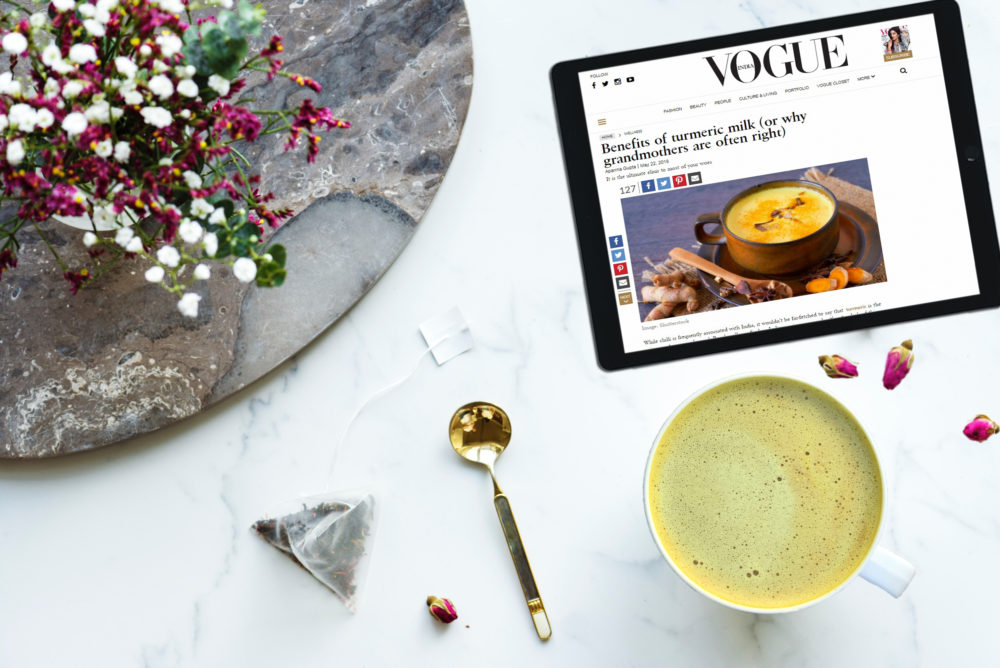It is the ultimate elixir to most of your woes
While chilli is frequently associated with India, it wouldn’t be far-fetched to say that turmeric is the spice most commonly used. Rarely will you find an Indian recipe prepared without a dash of this golden-yellow powder, whether it’s your daily vegetables and dals to rice preparations. A mainstay in all Indian kitchens, turmeric is derived from a ginger-like underground stem that is cultivated mostly in India. Growing up, this spice box staple was the answer to all health and skin woes in most of our grandmothers’ little book of wellness. Whether you got tanned playing out in the sun too long, had a chronic cold or a simple bruise, the humble turmeric was the antidote to everything. And as we’ve found out, it was with good reason.

The spice provides innumerable benefits by itself but mix it with milk, and its advantages increase by tenfolds. What was once something mothers and grandmothers coaxed and forced us into gulping down, has become an international health phenomenon—and all the “golden milk” posts on Instagram only reinforce the fact. Here, we list out all the reasons turmeric milk should be part of your wellness arsenal.
How turmeric milk benefits your health
One of the reasons why turmeric is so freely sprinkled in all Indian dishes is because it holds the power of boosting one’s immune system. Curcumin, the component within turmeric which is responsible for its miracle powers, has anti-inflammatory, antiseptic and antibacterial properties. Consuming a glass of turmeric milk at night is the norm for most growing Indian kids, as this concoction not only provides relief from sniffles and coughs, but also protects against further infections. Whether it is young children, lactating mothers, or patients recuperating after a surgery, turmeric milk is given to all to build the body’s immunity, and help it fight against external aggressors and diseases.
But why do we need a dedicated drink to extract the benefits of curcumin, considering that we take a heavy pinch of it in all our meals? “We mix turmeric with milk because curcumin is fat soluble, and when mixed with milk, it gets absorbed by the body quickly,” explains nutrition consultant Sangeeta Khanna. Many like Gita Ramesh, joint managing director, Kairali Ayurvedic Group, also believe that adding turmeric to your night-time glass of milk is an easy way to up its nutrition value.
Ramesh believes that if your immunity is a concern for you, turmeric milk should be consumed throughout the year. “It works better on a long-term basis than an SOS basis. It helps in digestion and keeps bloating and heart burn at bay. It does have immediate results on colds and coughs too, as it removes excess phlegm from the body. Full of antioxidants, it improves the wellbeing of the internal body organs,” explains Ramesh. Turmeric also acts as a blood purifier and flushes out toxins from the system. If you are experiencing a sinus headache, a cup of turmeric milk might provide relief, as it eases mucus flow and promotes sinus drainage.
Turmeric latte vs turmeric milk
The basic method for preparing turmeric milk is to heat the milk, add a teaspoon of powdered turmeric and stir it with a dash of honey/sugar, if you prefer it sweet. However, to get maximum benefits from the drink, it is best to have it without jaggery or sugar, and use fresh rhizome to make the paste. “However, since there are availability and convenience limitations to this, good quality powdered turmeric works,” states Ramesh, who has also written books on Ayurveda, including The Ayurvedic Cookbook.
When the Western world woke up to ‘Turmeric Latte’, and the internet was buzzing with health benefits of this wonder spice, Indians the world over were collectively amused at the royal status their grandmother’s humble potion was garnering. “But most of the people I know have hated the taste of haldiwala doodh with all their might. I agree it can taste really awful if made wrongly. Call it turmeric latte, and people might take an interest in tasting it for the first time too,” observes Khanna.
She has a recipe (for whatever you may want to call it, turmeric milk or turmeric latte), that is so delicious that you might trade a cup of coffee with it—mix equal quantities of milk and water together and bring to a simmer. Then, heat some ghee in a pan and tip in the turmeric powder. Keep the flame low and let the turmeric powder get cooked for a couple of seconds, till it gets aromatic. Now, take the pan off the heat and some sprinkle pepper, cinnamon and nutmeg powders, and mix them well, either by shaking the pan a little or with a spatula. Pour the hot milk and water mix over the pan, and bring to a light boil. Take it off the heat, add a sweetener of your choice and serve it immediately. She adds, “It’s best to combine turmeric with a pinch of pepper, as curcumin shows increased bioavailability in the presence of piperine, which is one of the active compounds of black pepper. This combination of turmeric and pepper works even better with some cinnamon and nutmeg, when added to turmeric milk.”
There are times when milk itself is not accepted by all. “Many of our guests are on a lactose-free diet due to allergies or lifestyle choices. Turmeric is one of the ingredients in our anti-inflammatory shot. Then, that’s the time we prepare turmeric shots with almond milk or coconut milk,” says Dr Manoj Kutteri, qualified ayurvedic physician and wellness director at Atmantan Wellness Resort.
Antidepressant effect of turmeric milk
Drinking warm milk at bedtime was granny’s remedy for insomnia, which can gain potency with the addition of turmeric. Milk contains tryptophan, but its bioavailability to the brain is limited because of the other competing amino acids present; curcumin can change that. Ground turmeric, which has been used in Ayurvedic and Chinese medicine for centuries, is being actively studied by modern scientists. Turmeric milk or golden milk shows promise as a treatment for depression, and studies have shown that curcumin could potentially treat inflammation relating to mood disorders as well.
Turmeric milk’s beauty benefits
A glass of turmeric milk was traditionally given to brides-to-be to brighten their complexion. Apparently, it’s more than just an old wives tale. Curcumin has antibacterial and anti-inflammatory properties which do help in combatting acne and clarifying the complexion. In fact, cow’s milk and turmeric are famed to be a DIY cleanser-moisturiser. For long, the key to radiant and glowing complexion in India lay in a mixture of malai or fresh cream with a dash of haldi, which is applied as an instant glow mask. This actually works, especially for normal to dry complexions, if you can tolerate the smell of malai. For oily skin types, turmeric with yoghurt works as the ultimate skin brightener, and fixes dull complexion and stubborn tanning.
Kasturi haldi, which is commonly available in south India, is an amazing ingredient for facial and beauty treatments. Deepshikha Deshmukh, founder of the green beauty line, Love Organically, remembers growing up using natural ingredients for beauty scrubs, packs and uptans. One of her favourite DIY recipes involves amba haldi and raw rice, grounded with malai to make a smooth scrub for the body. “This is a beautiful recipe, as this super hydrating scrub brightens the complexion and sloughs off dead skin,” she says.
So the next time you’re seeking a remedy for whatever your skin and health concern is at that moment, instead of looking for the perfect solution online, it might be a good idea to call your grandmother, instead.
This article was first published in vogue.in





